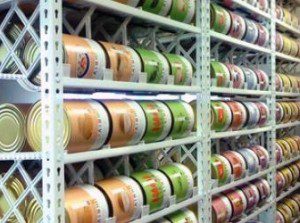
Guest Post By Gaye Levy
Contributing Writer for Wake Up World
One of the more common prepper
challenges is finding room for stored food and water. Lucky you if you
have a large home with a basement or cellar – you have plenty of space
at just the right temperature. But the rest of us? Not so much. Many
people live in apartments, condos, mobile homes, RV’s or, in my case, a
one bedroom cottage. This means we are cramped for normal pantry and
closet space let alone space for our emergency food and water.
Couple the lack of storage space with
the six enemies of food storage (temperature, moisture, oxygen, light,
pests and time) and the storage problem compounds exponentially.
This does not have to be an impossible
situation. With a bit of creativity, almost everyone can find a bit of
extra space for their emergency food storage.
So with that in mind, today I would like
to offer some ideas for storing food for the space challenged. I am
going to do this by using my own home as an example.
In the photos below you will see the
results of my walk-around assessment of usable storage space in my own
home. As embarrassing as it might seem to expose my messes and
disorganization for the world to see, I think it will help give you some
ideas where you too can find some extra space in your own home.
16 Food Storage Tips for the Space-Challenged Prepper
1. Build some shelves under the stairwell
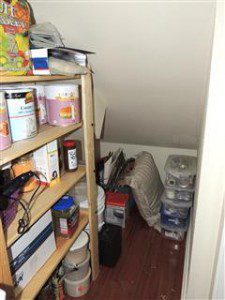 If
you are like me, that awkward space under the stairwell is a big mess. I
actually cleaned this area out before taking the photo – that is how
bad it was. If you don’t want to build shelves, consider putting some
buckets along the back wall then placing a board on top. On top of this
make-shift shelf you can store #10 tins or canned and packaged foods.
This is going to be the number one makeover in my home.
If
you are like me, that awkward space under the stairwell is a big mess. I
actually cleaned this area out before taking the photo – that is how
bad it was. If you don’t want to build shelves, consider putting some
buckets along the back wall then placing a board on top. On top of this
make-shift shelf you can store #10 tins or canned and packaged foods.
This is going to be the number one makeover in my home.2. Shelves above the washer and dryer
The area above the washer and dryer is
not ideal since it is prone to heat and humidity. Still, if you are
diligent about rotating on an annual basis, this area is perfectly
acceptable for storing some canned goods or Mylar bags filled with rice, beans or oatmeal.
In my case I have some dead space next to the cupboard – perfect for a shelf or two.
3. Build some shallow shelves behind the clothes in your closet
Most closets are far deeper than
necessary for your hanging clothes. Adding a shelf just wide enough to
hold canned goods will take advantage of this extra space without
compromising your clothing one bit.
4. Clear out the junk on the shelf above your clothes in the closet
 Talk
about a waste of space. I have stored some decorative shams up on the
closet shelf above my hanging clothes. I used to keep the shams on the
bed but to tell the truth, it made making the bed too much trouble so
now I pull them out when company is coming. Most certainly, these
pillows can be stored in my garage where it gets really hot in the
summer and really cold in the winter.
Talk
about a waste of space. I have stored some decorative shams up on the
closet shelf above my hanging clothes. I used to keep the shams on the
bed but to tell the truth, it made making the bed too much trouble so
now I pull them out when company is coming. Most certainly, these
pillows can be stored in my garage where it gets really hot in the
summer and really cold in the winter.5. Shelves on the backs of doors
As an alternative to shelves, you can purchase some inexpensive over the door shoe organizers for storing canned goods or bottled water.
6. Stack canned goods or jugs of water behind the sofa
If your sofa is pushed up against a
wall, consider moving it out a few inches and using this new found space
for food and water storage.
7. Shelves under the sink
As long as the food you store under the
sink is well sealed, it is perfectly okay to use this space for storage.
Consider a shelf just wide enough to hold soda or juice jugs filled
with rice or beans – perfect.
8. Storage in the deep recesses of your cupboards
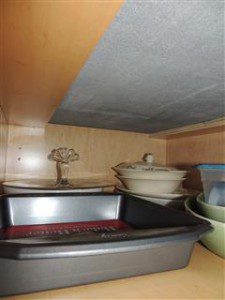 This
is a storage area I had not thought of before. The back on the very top
shelves of my cupboards are areas that I consider to be no-mans land. I
climbed up on a step stool to peek inside and stored there are cups and
saucers that I never use, odds and ends of glassware, and items I have
dragged from home to home during my 38 years of marriage. This stuff
should be thrown out or given away. Why do I keep this stuff?
This
is a storage area I had not thought of before. The back on the very top
shelves of my cupboards are areas that I consider to be no-mans land. I
climbed up on a step stool to peek inside and stored there are cups and
saucers that I never use, odds and ends of glassware, and items I have
dragged from home to home during my 38 years of marriage. This stuff
should be thrown out or given away. Why do I keep this stuff?
Take a look inside your own cupboards.
Do you have casserole dishes you never use? How about the “good china”
that is only used once a year if that often? These are candidates for
the garage or the garage sale. Box them up and make room for your food
storage.
9. Storage above the refrigerator
Ditto the above. Mine is too high to get
to on a daily basis and too deep to be practical. At the very least,
the back of the area above the refrigerator can be used to emergency
food storage.
10. Storage in decorative baskets
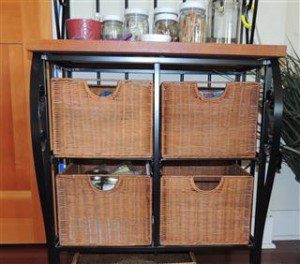 This
is one of my favorites. I love baskets and use them to store all sorts
of things in plain sight. I use one for my bread making supplies,
another for pet food and treats, another as a potato bin. These are
right there in my living room but no one is the wiser. Like I said,
hidden in plain sight.
This
is one of my favorites. I love baskets and use them to store all sorts
of things in plain sight. I use one for my bread making supplies,
another for pet food and treats, another as a potato bin. These are
right there in my living room but no one is the wiser. Like I said,
hidden in plain sight.11. Storage behind the books on your bookshelf
If you happen to collect books, think
about pulling the books out toward the edge of the shelf and storing
food behind the books.
12. Storage under the bed
This one is easy so I am surprised more
people don’t consider this option. Not only that, you can use some
well-placed bricks to raise your bed and to increase the height of your
under-bed storage area.
13. Storage under the sofa or other pieces of furniture
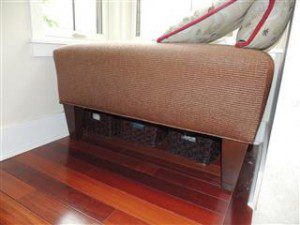 Do
not discount the shallow storage area under your sofa, chairs or other
furniture. This is where I store my extra large 15” cast iron skillet
(my 12” skillet calls the oven home) as well as my baking sheets, pizza
peel, board games and other items. As you walk around your own home and
inventory space, be on the lookout for things that can be moved around
and stored in out of the way places such as under the furniture.
Do
not discount the shallow storage area under your sofa, chairs or other
furniture. This is where I store my extra large 15” cast iron skillet
(my 12” skillet calls the oven home) as well as my baking sheets, pizza
peel, board games and other items. As you walk around your own home and
inventory space, be on the lookout for things that can be moved around
and stored in out of the way places such as under the furniture.14. Fill up those empty suitcases
Unless you are a business traveler,
chances are you only use your luggage once or twice a year. Empty
suitcases are ideal for storing food that has been packaged in Mylar
or FoodSaver bags. This works equally well for pastas, rice, cereals and
other packaged items from the grocery store.
Consider storing the individual packages
of food in a large garbage bag then stuffing the whole thing into a
suitcase. That way you can simply remove the single large bag when you
are ready to travel, set it aside for the duration of your trip, then
replace it when you get home.
As a bonus, if you need to evacuate, you can grab your suitcase full of food and take it with you. Pretty neat, huh?
15. Store buckets in the bathtub
I know people that never take a bath or
do so only occasionally. This is not to say they are dirty – they simply
prefer the shower. Why not fill the bathtub with well sealed buckets of
food? You can put up a nice shower curtain and no one will be the
wiser. You could also store a bucket or two in the shower. Removing it
before turning on the water is not such a big deal, after all.
By the way, the reason you want to use a
bucket in the shower is so that the humidity from the bathroom does not
leach into your food. That, plus the fact that is easy to just hoist
the bucket and set it aside – so much easier than a bunch of separate
packages or cans.
16. Build a loft for storage in the garage
 We
built a storage loft in our garage. If you do not have a high peaked
ceiling like we did, you can put a shelf around the upper perimeter of
the garage instead. This is a great place to store those little used
kitchen appliances, off season clothes and other little used items –
making room inside your home for more food.
We
built a storage loft in our garage. If you do not have a high peaked
ceiling like we did, you can put a shelf around the upper perimeter of
the garage instead. This is a great place to store those little used
kitchen appliances, off season clothes and other little used items –
making room inside your home for more food.Making It All Worthwhile
There are some factors to keep in mind
as you evaluate these hidden food storage locations in your home. The
first is simply this: your stored food should be used, replaced and
rotated. This is especially true if your storage conditions are not
optimal.
Let me give you an example. You live in a
warm, humid climate and do not have air-conditioning. On a hot summer
day, the temperature inside your home may be 80F and the humidity may be
80%. Okay, it is what it is. Rather than fret about the diminished
shelf life of your stored food, plan on using it after a year or two. As
long as you replace what you use, you are fine. You food will still be
nutritious and edible so rotate it into your day-to-day food pantry and
eat it.
The other thing is that your food
storage is “not an inheritance for your grandchildren”. I wish I can
claim credit for that statement but it belongs to Barbary Salsbury, the
author of Preparedness Principles: The Complete Personal Preparedness Resource Guide for Any Emergency Situation. I had the pleasure of meeting Barbara a couple of months ago and I was knocked to my senses by this statement.
It is okay to purchase what you need to
get you through a one month or even a one year emergency. But use your
food. Cook with it and it eat it. Learn to cook your food outdoors,
perhaps in a fire pit or on a rocket stove. Try eating it cold. Learn
what you like and what you will take a pass on the next time around. But
most of all, don’t think that you have to hoard your food. Eat it,
enjoy it and replace it.
The Final Word
Now that you are armed with some great
(I hope) ideas, take a stroll around your own home. Look for your own
set of hidey holes and or areas where junk has accumulated and think
about how, with a wee bit or organization and handyman skills, you can
store some extra food.
Enjoy your next adventure through common sense and thoughtful preparation!











I would love to have some proper storage in Edmonton so thank you for sharing this.
ReplyDelete